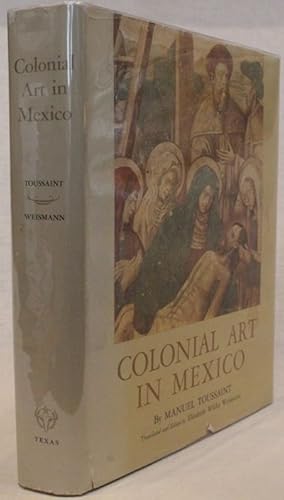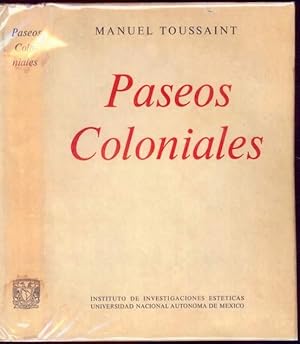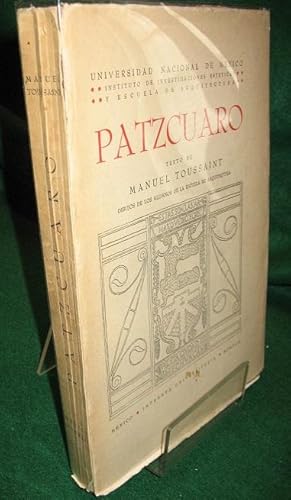TOUSSAINT Y RITTER, MANUEL 1890 1955 (3 resultados)
Tipo de artículo
- Todo tipo de artículos
- Libros (3)
- Revistas y publicaciones
- Cómics
- Partituras
- Arte, grabados y pósters
- Fotografías
- Mapas
-
Manuscritos y
coleccionismo de papel
Condición
- Todo
- Nuevos
- Antiguos o usados
Encuadernación
Más atributos
- Primera edición (2)
- Firmado
- Sobrecubierta (2)
- Con imágenes del vendedor
- Sin impresión bajo demanda
Ubicación del vendedor
Valoración de los vendedores
-
Colonial Art in Mexico
Publicado por University of Texas Press, Austin, 1967
Librería: The Book Collector, Inc. ABAA, ILAB, Fort Worth, TX, Estados Unidos de America
Libro Original o primera edición
Hardcover. Condición: Very Good. Estado de la sobrecubierta: Very Good. 1st Edition. xxvi+493 pages with frontispiece, index, bibliography and 395 plates. Quarto (11 1/4" x 9"). bound in original publisher's gold cloth with black and gilt decorative lettering to spine in original pictorial jacket. Translated and edited by Elizabeth Wilder Weismann from the second Spanish edition. First American edition. The three hundred years between conquest by Spain and the winning of independence saw a special and characteristic culture develop in Mexico. This was a frontier society, but a rich one, with all the resources of imperial Spain and the Roman church to develop and support the natural wealth of the land. Public and private buildings were ornamented with rich sculpture and embellished with colorful paintings depicting religious scenes and views of daily life. In this period the preponderantly Indian population was converted to the Christian faith and introduced to the civilization of post-Renaissance Europe. Artists came to Mexico from the Old World and brought with them the current styles, but most of the practicing artisians had never seen Europe, Natives of New Spain, of both Indian and Spanish blood, developed the imported styles in new modes appropriate to the new country that was to be come Mexico. It is this great corpus of art, ranging from the Primitive and Medieval through Renaissance and Baroque to the nineteenth century Neoclassic and popular art, which this book presents. It is the cornerstone of the study of Mexican colonial art. Condition: Edges bumped. Jacket spine sunned, edges chipped with tears and closed tears, front edges sunned, spine ends chipped else a very good copy in like jacket.
-
Paseos Coloniales
Publicado por Universidad Nacional Autonoma de Mexico (UNAM), Mexico City, 1962
Librería: The Book Collector, Inc. ABAA, ILAB, Fort Worth, TX, Estados Unidos de America
Libro
Hardcover. Condición: Very Good. Estado de la sobrecubierta: Very Good. 2nd Edition. viii+162p with 216 plates and index. Quarto (11" x 8 1/2") issued in beige cloth with black label and gilt lettering to spine. Limited to 3000 copies. Instituto de Investagaciones Estetecas Number 2. 2d edition. In 1939, the National University of Mexico (UNAM) published the book entitled, Paseos Coloniales, written by the great colonial art specialist, Manuel Toussaint, founder of the chair of colonial art and the Institute of Aesthetic Research at the UNAM. The book is, in the words of the author, a "mosaic of articles written over twenty years". It consists of nineteen articles that serve as a "guide" for visiting monuments, a city or a part of history, from the comfort of your home or your library. The work is not of the academic caliber of some of his other works on Colonial Painting and Art, but it provides information on the "discoveries" in an interesting and charming way, full of emotion and youthful enthusiasm. Condition: Tape stain on front end paper. Jacket edge wear with some tears and chips, lightly soiled and stained. A very good copy in like jacket.
-
Patzcuaro
Publicado por Imprenta Universitaria, Mexico City, 1942
Librería: The Book Collector, Inc. ABAA, ILAB, Fort Worth, TX, Estados Unidos de America
Libro Original o primera edición
Soft cover. Condición: Good. 1st Edition. xiii+288+[errata] pages with plates, figures, maps (2 folding) and index. Small folio (11 3/4" x 8") bound in original wrappers. First edition. Pátzcuaro is a large town and municipality located in the state of Michoacán. The town was founded sometime in the 1320s, at first becoming the capital of the Tarascan state and later its ceremonial center. After the Spanish took over, Vasco de Quiroga worked to make Pátzcuaro the capital of the New Spain province of Michoacán, but after his death, the capital would be moved to nearby Valladolid (today Morelia). Pátzcuaro has retained its colonial and indigenous character since then, and has been named both a "Pueblo Mágico" and one of the 100 Historic World Treasure Cities by the United Nations. In 1538, the Spanish established their settlement in Pátzcuaro, founding the Diocese of Michoacán with Vasco de Quiroga as first bishop. Pátzcuaro was made the capital of the new Spanish province. The 1540s saw a repopulation of the area with Bishop Vasco de Quiroga convincing many of the Indians to return and brought in a number of Spanish families. For this Vasco de Quiroga is considered to be the founder of modern Pátzcuaro. He renamed the city as the City of Michoacán, which was confirmed by royal decree in 1553, with Pátzcuaro receiving its current coat of arms. The cathedral was constructed over the temple dedicated to the goddess Cueráppari. Vasco de Quiroga wanted to build an ambitious cathedral here, with five naves, but this was declared unacceptable by the Spanish crown and only one of the naves was built. It remains to this day. Pátzcuaro remained the largest city in the Spanish province until about ten years after Vasco de Quiroga's death. Condition: Edge wear with some chips, spine ends chipped, front hinge beginning, corners bumped else a good to very good copy.




